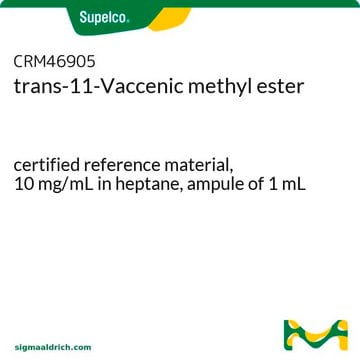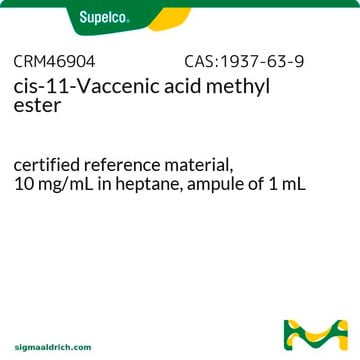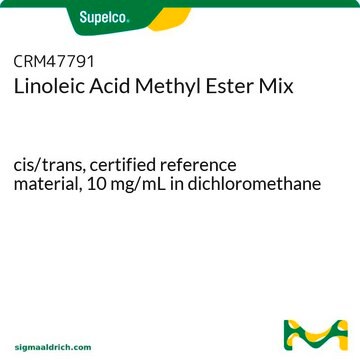46903
trans-9-Octadecenoic methyl ester
10 mg/mL in heptane, analytical standard
Synonym(s):
Methyl elaidate, Elaidic acid methyl ester, Methyl trans-9-octadecenoate
About This Item
Recommended Products
grade
analytical standard
CofA
certificate of analysis is enclosed in each package.
packaging
ampule of 1 mL
concentration
10 mg/mL in heptane
technique(s)
HPLC: suitable
gas chromatography (GC): suitable
density
0.871 g/mL at 20 °C (lit.)
format
single component solution
storage temp.
−20°C
SMILES string
CCCCCCCC\C=C\CCCCCCCC(=O)OC
InChI
1S/C19H36O2/c1-3-4-5-6-7-8-9-10-11-12-13-14-15-16-17-18-19(20)21-2/h10-11H,3-9,12-18H2,1-2H3/b11-10+
InChI key
QYDYPVFESGNLHU-ZHACJKMWSA-N
Looking for similar products? Visit Product Comparison Guide
Application
replaced by
Signal Word
Danger
Hazard Statements
Precautionary Statements
Hazard Classifications
Aquatic Acute 1 - Aquatic Chronic 1 - Asp. Tox. 1 - Flam. Liq. 2 - Skin Irrit. 2 - STOT SE 3
Target Organs
Central nervous system
Storage Class Code
3 - Flammable liquids
WGK
WGK 2
Flash Point(F)
24.8 °F
Flash Point(C)
-4 °C
Choose from one of the most recent versions:
Already Own This Product?
Find documentation for the products that you have recently purchased in the Document Library.
Our team of scientists has experience in all areas of research including Life Science, Material Science, Chemical Synthesis, Chromatography, Analytical and many others.
Contact Technical Service












